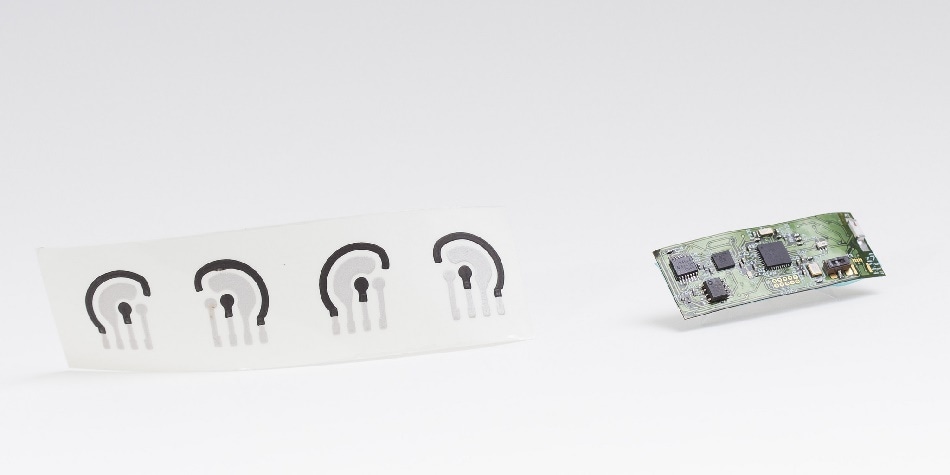Aug 4 2016
 The alcohol sensor consists of a temporary tattoo (left) developed by the Wang lab and a flexible printed electronic circuit board (right) developed by the Mercier lab. (CREDIT: UC San Diego)
The alcohol sensor consists of a temporary tattoo (left) developed by the Wang lab and a flexible printed electronic circuit board (right) developed by the Mercier lab. (CREDIT: UC San Diego)
A team of engineers at the University of California San Diego have created a flexible wearable sensor capable of accurately measuring the blood alcohol level from sweat and convey the data wirelessly to a smartphone, laptop, or other mobile device.
It is possible to wear the device on the skin and could be used by police officers and doctors for real-time, uninterrupted, and non-invasive monitoring of blood alcohol content.
The device has a temporary tattoo that can be stuck on the skin. The tattoo induces sweat and electrochemically detects the level of alcohol. The device also has a portable flexible electronic circuit board, which is linked to the tattoo with a magnet and can transfer the data to a mobile device via Bluetooth.
The research was led by nanoengineering professor Joseph Wang and electrical engineering professor Patrick Mercier, both from UC San Diego. The findings have been published in the ACS Sensors journal.
Lots of accidents on the road are caused by drunk driving. This technology provides an accurate, convenient and quick way to monitor alcohol consumption to help prevent people from driving while intoxicated.
Joseph Wang, Nanoengineering Professor, UC San Diego
The device could be combined with alcohol ignition interlocks in a car, or friends could use it to monitor each other before handing over the car keys, he further explained.
“When you’re out at a party or at a bar, this sensor could send alerts to your phone to let you know how much you’ve been drinking,” said Jayoung Kim, a materials science and engineering PhD student in Wang’s group and one of the paper’s co-first authors.
The most accurate indicator of a person’s alcohol level is the blood alcohol concentration, however to measure it you need to prick a finger. The most commonly used breathalyzers are non-invasive, but they do not give correct readouts.
For instance, the alcohol level detected in a person’s breath immediately after drinking an alcoholic beverage would usually appear higher than the person’s actual blood alcohol concentration. Also, by using mouthwash a person can fool the breathalyzer into detecting a lower alcohol level.
Recent research has revealed that blood alcohol concentration can also be predicted by measuring alcohol levels in “insensible sweat” - perspiration that occurs before it is perceived as moisture on the skin. However, this measurement falls about two hours behind the actual blood alcohol reading.
In contrast, the alcohol level in “sensible sweat” - the sweat that is usually seen - is a superior real-time indicator of the blood alcohol concentration, but up to now the systems that can measure this are not portable or fit to wear on the body.
Now, UC San Diego engineers have built an alcohol sensor that is portable, wearable, and could monitor alcohol level in sweat accurately in 15 minutes or less.
“What’s also innovative about this technology is that the wearer doesn’t need to be exercising or sweating already. The user can put on the patch and within a few minutes get a reading that’s well correlated to his or her blood alcohol concentration. Such a device hasn’t been available until now,” Mercier said.
How it Works
Wang and Mercier, the director and co-director of the UC San Diego Center for Wearable Sensors, worked together to design the device. Wang’s team fabricated the tattoo, which has screen-printed electrodes and a small hydrogel patch containing pilocarpine, a drug that can be absorbed through the skin and induce sweat.
Mercier’s team designed the printed flexible electronic circuit board that provides power to the tattoo and can communicate wirelessly with a mobile device. His team also built the magnetic connector that connects the electronic circuit board to the tattoo, as well as the phone app in the device.
This device can use a Bluetooth connection, which is something a breathalyzer can’t do. We’ve found a way to make the electronics portable and wireless, which are important for practical, real-life use.
Somayeh Imani, PhD student, UC San Diego
The tattoo induces sweat by releasing pilocarpine. Then, the sweat makes contact with an electrode coated with alcohol oxidase, an enzyme that selectively reacts with alcohol to produce hydrogen peroxide, which is electrochemically detected. That data is transmitted to the electronic circuit board as electrical signals. The data is then communicated wirelessly to a mobile device.
Putting the Tattoo to the Test
Nine healthy volunteers wore the tattoo on their arms before and after drinking an alcoholic beverage (a glass of red wine or a bottle of beer) for the test. The readouts from the alcohol sensor accurately revealed the wearers’ blood alcohol concentrations. Even after repeated shaking and bending, the device continued to provide accurate readouts. This confirmed that the sensor will not be affected by the movements of the wearer, the researchers stated.
The team is now looking at building a device that could constantly monitor alcohol levels for 24 hours.